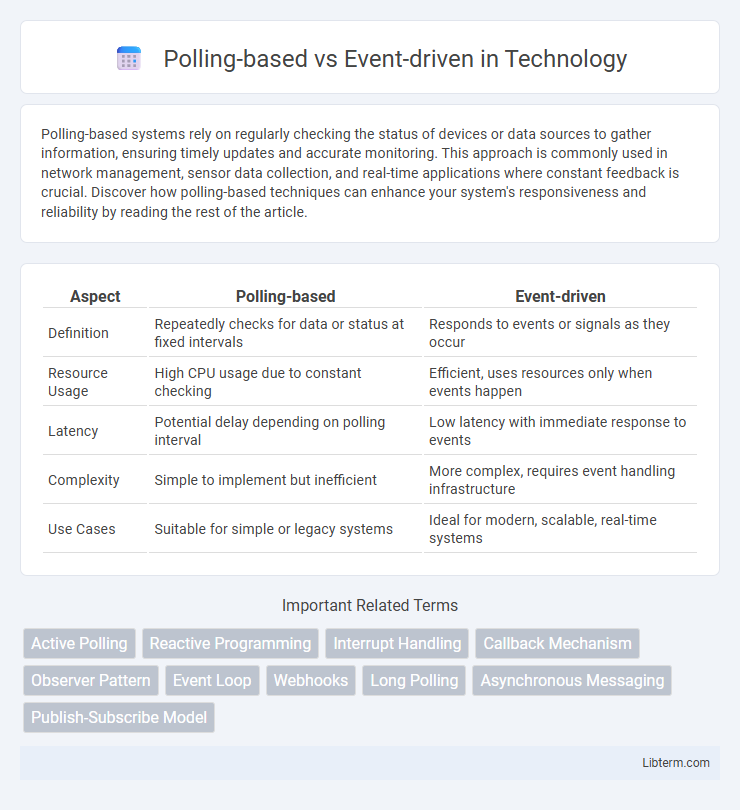Polling-based systems rely on regularly checking the status of devices or data sources to gather information, ensuring timely updates and accurate monitoring. This approach is commonly used in network management, sensor data collection, and real-time applications where constant feedback is crucial. Discover how polling-based techniques can enhance your system's responsiveness and reliability by reading the rest of the article.
Table of Comparison
| Aspect | Polling-based | Event-driven |
|---|---|---|
| Definition | Repeatedly checks for data or status at fixed intervals | Responds to events or signals as they occur |
| Resource Usage | High CPU usage due to constant checking | Efficient, uses resources only when events happen |
| Latency | Potential delay depending on polling interval | Low latency with immediate response to events |
| Complexity | Simple to implement but inefficient | More complex, requires event handling infrastructure |
| Use Cases | Suitable for simple or legacy systems | Ideal for modern, scalable, real-time systems |
Introduction to Polling-Based and Event-Driven Architectures
Polling-based architectures repeatedly check the status of devices or resources at regular intervals, which can lead to increased CPU usage and latency. Event-driven architectures respond instantly to specific triggers or events, optimizing resource efficiency and improving real-time responsiveness. Choosing between polling-based and event-driven models depends on system requirements for responsiveness, resource availability, and complexity.
Defining Polling-Based Systems
Polling-based systems continuously check the status of a device or resource at regular intervals to detect changes or events. This method relies on repeated queries, which can introduce latency and increase CPU utilization due to frequent checks, especially when no events occur. Despite these inefficiencies, polling-based systems are simple to implement and are beneficial in environments where event detection timing is predictable.
Understanding Event-Driven Systems
Event-driven systems operate by responding to specific events or changes in state, triggering actions only when necessary, which enhances efficiency and resource utilization compared to polling-based systems that continuously check for events. These systems rely on event listeners or handlers that detect and process signals from hardware, user inputs, or software messages, enabling real-time responsiveness and scalability in applications such as UI frameworks, network servers, and IoT devices. Understanding event-driven architecture is crucial for designing responsive, asynchronous applications that minimize latency and improve overall system performance.
Core Differences Between Polling and Event-Driven Approaches
Polling continuously checks the status of a resource or device at regular intervals, leading to potential CPU inefficiency and increased latency when waiting for an event. Event-driven approaches rely on interrupts or signals, enabling immediate response to changes without constant resource checking, optimizing CPU usage and reducing response time. Core differences include the proactive nature of polling versus the reactive mechanism of event-driven, impacting system performance and resource management.
Performance Considerations: Polling vs Event-Driven
Polling repeatedly checks the status of a resource, leading to higher CPU usage and increased latency due to constant query cycles, whereas event-driven mechanisms respond only when events occur, optimizing resource utilization and reducing response time. Event-driven architectures enhance performance by minimizing unnecessary processing and enabling scalable, real-time interactions. Polling may degrade system performance under high load, while event-driven designs maintain efficiency in dynamic environments.
Scalability and Resource Efficiency Comparison
Polling-based architectures consume more CPU cycles and memory as system size grows due to continuous status checks, leading to scalability limitations and increased energy consumption. Event-driven systems optimize resource efficiency by triggering processes only when specific events occur, enabling better scalability in distributed and high-load environments. This approach reduces unnecessary processing overhead and latency, supporting dynamic resource allocation for improved overall system performance.
Real-World Use Cases for Polling-Based Models
Polling-based models are widely used in embedded systems and legacy hardware where continuous status checks ensure timely response without complex interrupt handling. Industrial automation often relies on polling to monitor sensors and machinery due to its predictability and simplicity in real-time control systems. Network devices like routers and switches implement polling mechanisms to regularly check for incoming data packets while maintaining system stability and reducing missed events.
Practical Examples of Event-Driven Applications
Event-driven applications react to user actions, sensor inputs, or system messages to enhance responsiveness, such as chat applications processing incoming messages instantly or smart home systems adjusting lighting based on motion detection. In contrast, polling-based systems periodically check for new data, resulting in potential delays and inefficient resource use. Real-time stock trading platforms and interactive gaming environments exemplify event-driven designs, maximizing performance by handling events the moment they occur.
Choosing the Right Approach: Key Decision Factors
Choosing the right approach between polling-based and event-driven systems depends on factors like resource efficiency, latency requirements, and system complexity. Polling suits scenarios with predictable, low-frequency updates but may waste CPU cycles and increase latency. Event-driven architectures excel in responsiveness and scalability, especially for real-time applications, but require more complex event handling and infrastructure.
Future Trends in System Design: Polling vs Event-Driven
Future trends in system design increasingly favor event-driven architectures due to their scalability and efficiency in handling real-time data and asynchronous processes. Polling methods, while simpler, often lead to resource wastage and latency issues, making them less suitable for modern distributed systems and IoT applications. Advances in event-driven frameworks and serverless computing are accelerating adoption, enhancing responsiveness and reducing infrastructure costs.
Polling-based Infographic

 libterm.com
libterm.com